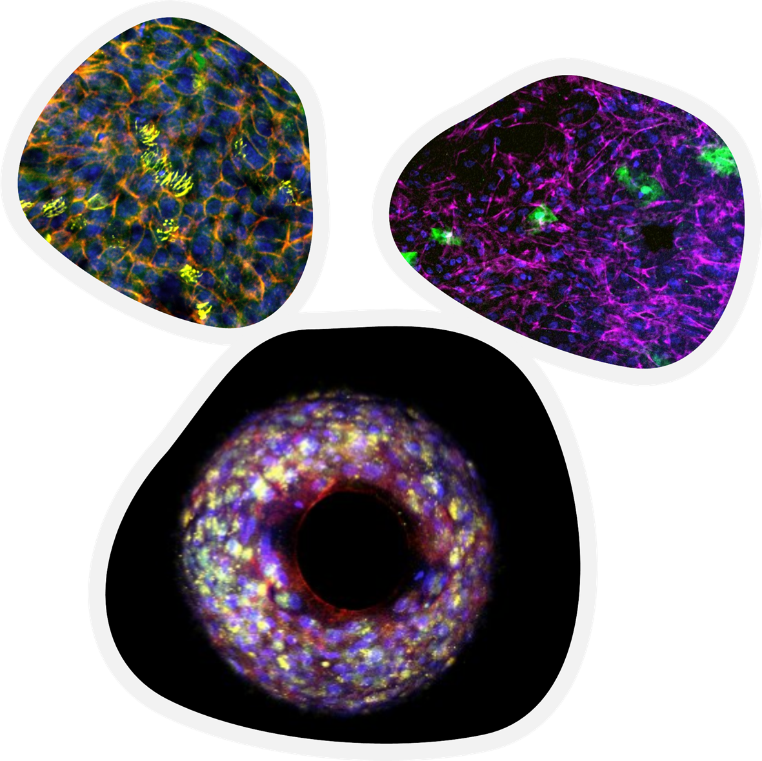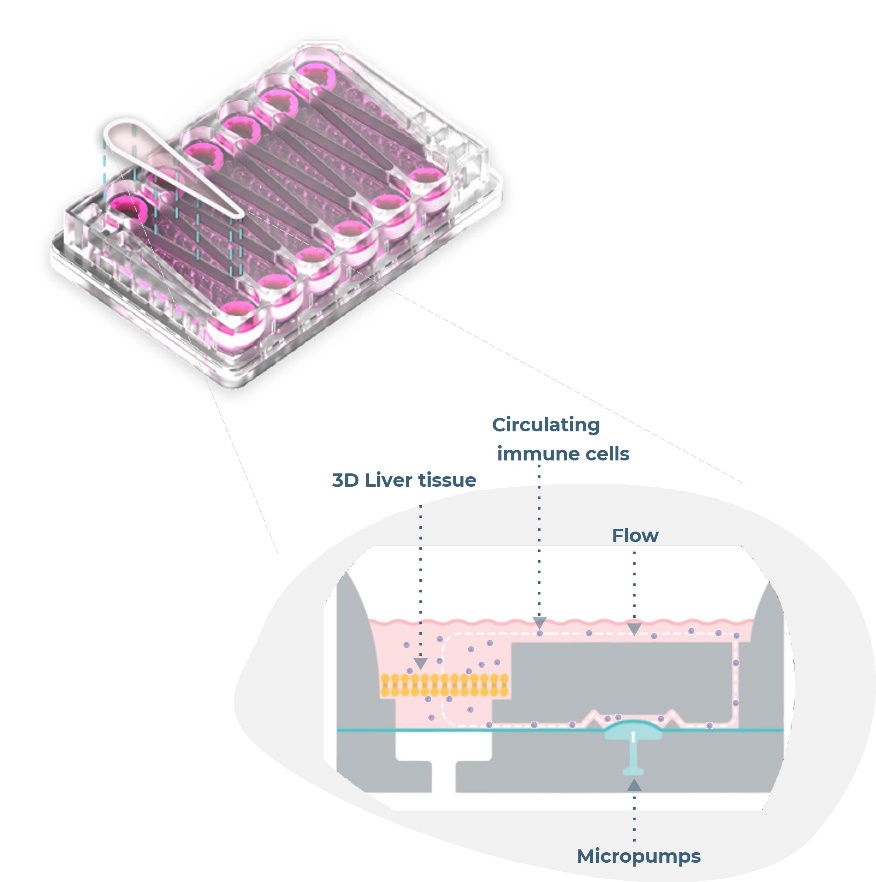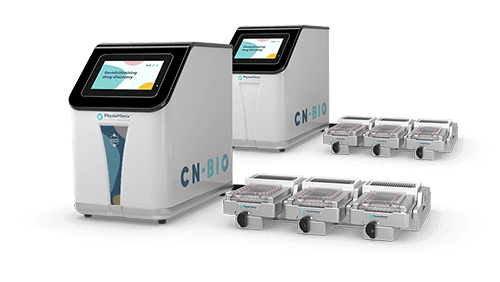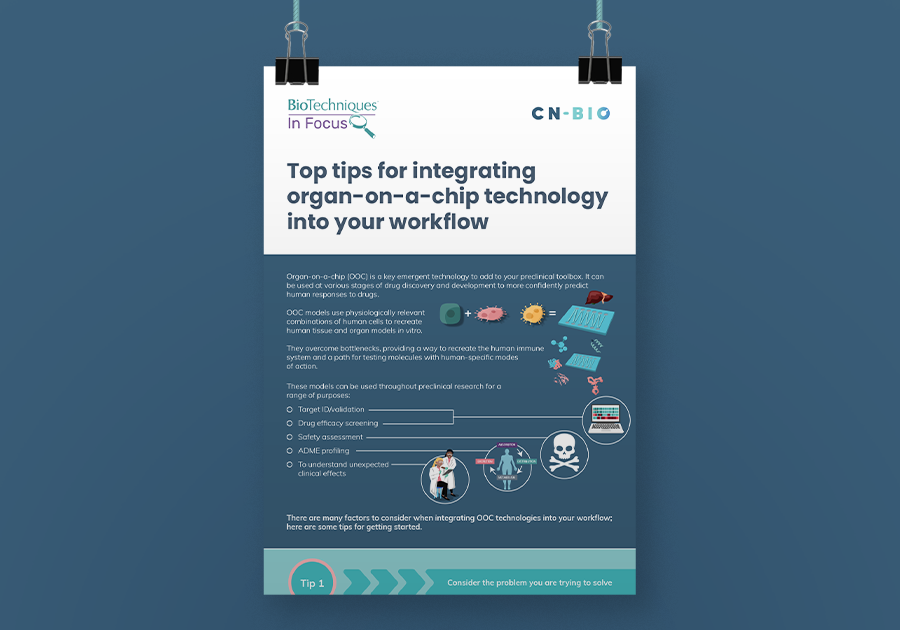Welcome to part two of our blog series exploring the FDA’s announcement to phase out the animal testing requirement for monoclonal antibodies (mAbs), and other drugs, in favor of human-relevant new approach methodologies (NAMs).
In part one of the blog, we unpicked the reasons behind the FDA’s decision to focus on mAbs first, and steps to ensure that a NAM-based approach will offer the same degree of safety as animals before their use is phased out.
If you missed it, read Part one “Why has the FDA loosened its grip on animal testing for mAbs?” here.
In “Microphysiological systems for mAbs”, we continue the commentary by taking a deeper dive into the PhysioMimix® OOC range of microphysiological systems, also known as organ-on-a-chip (OOC). We explore how microphysiological systems address the shortcomings of animal models for mAb development and the role that CN Bio is taking to support your switch to a NAMs-based approach.
Use of microphysiological systems for mAbs to address animal shortcomings during development
At CN Bio, we have developed, characterized, validated and commercialized many PhysioMimix organ models and assays that have been successfully adopted by 16 of the top 20 Pharma. They can be used to test a range of drug modalities across disease modeling, safety toxicology and ADME applications, and are supported by “all-in-one” reagent kits to support rapid onboarding. Our customers have independently developed many more.

In their roadmap to reducing animal testing in preclinical safety studies, the FDA focuses much of their narrative on immune-related risk and how microphysiological systems can add a “crucial safety net that animal tests struggle to provide”. In principle, use of primary human cell-derived models avoids interspecies differences to reveal immune-related toxicological effects that are more relevant to humans; however, modeling the human immune system is challenging in all experimental setups – not just animals.
There is no doubt that microphysiological systems with closed-loop microfluidic designs, which re-circulate media around cultures are best equipped for mAb immunogenicity testing. Our PhysioMimix Liver-on-a-chip, (also known as a Liver microphysiological system/Liver MPS) is the furthest advanced in terms of immunocompetency. A key customer has already reported the initial characterization of a fully immunocompetent drug-induced liver injury (DILI) model – including circulating peripheral immune cells alongside the liver microtissues – at the Society of Toxicology conference, demonstrating that the basic design of PhysioMimix technology is on point. The development of these fully immunocompetent microphysiological systems for mAbs development is on the horizon. With the ability to report inflammatory responses and resulting organ damage to drugs, they will be game changers!

From immediate effect, companies that include NAMs-based data into therapeutic submissions to the FDA will be rewarded, for example, toxicology studies using animal and NAMs methods which show no concerning signals in one month can be reduced from six months to three months. Through close collaboration and joint expertise, we are confident in our ability to supply effective microphyiological system-based assays required for these tests, so that you can benefit from the regulatory relief promised by the FDA.
CN Bio’s closely forged links to primary human cell suppliers, including LifeNet Health, position us well to address current market challenges surrounding immunogenicity testing, such as HLA donor matching of all primary cell types required. Plus, our latest collaboration deal with CRO giant Pharmaron provides us with a greater potential to meet market needs for microphysiological systems for mAbs testing more rapidly.
Immune-mediated liver injury associated with mAbs
There are four types of immune-mediated injuries associated with monoclonal antibodies:
Idiosyncratic Reactions
These are unpredictable and often not dose-related, meaning patients may develop DILI even at low drug doses.
Autoimmune Hepatitis
mAbs can trigger an immune response that damages the liver.
Other Immune-Mediated Injury
The primary effect of the mAb can trigger an immune or non-immune response that results in liver injury.
Viral Reactivation
Immunosuppressive mAbs can reactivate latent viral infections, like HBV, which can cause liver damage.
Use of concomitant medications, like aminosalicylates or methotrexate, can also increase the risk of DILI when used with mAbs, as does the presence of underlying liver disease and genetic predisposition. How can the use of microphysiological systems for mAbs testing reduce the risk?
Liver MPS’ potential to detect immune-mediated liver injury
Human Liver MPS (co-cultures of hepatocytes with non-parenchymal cells under perfusion) have human liver metabolic competency and recapitulate human-specific responses. Our PhysioMimix Liver MPS has been extensively validated for predicting the DILI effects of small molecules, whilst proof of concept work evaluating their use for therapeutic antibody/small molecule drug-drug interaction responses, and the testing of newer, more human-specific drug modalities (where animal use is less suited) has also been demonstrated. Visit our DILI application page for more info.
A recent CN Bio blog, “Immune-mediated DILI – Predicting the unpredictable!, explores the additional benefits of a fully immunocompetent Liver MPS, where peripheral immune cells are incorporated into the system’s fluidic flow to circulate around liver microtissues. Assays utilizing these models facilitate the detection of cytokine release, T-cell activation, or other immunotoxicity, such as hepatocyte damage via clinical liver function test (LFT) markers. They enable effects that only manifest in human tissue to be detected, overcoming the limitations of animal tests. For more information, visit our immune-mediated liver injury webpage.
Although CN Bio’s fully immunocompetent assay is not yet widely available, the concept is verified, and the approach is built upon proven pedigree. A co-publication with the FDA’s CDER group concluded that data derived using PhysioMimix systems is appropriate for use in drug safety and metabolism applications, evidencing its enhanced performance versus standard techniques. It substantiated CN Bio’s position as a leader in the Organ-on-a-chip (OOC) field with reliable and robust cutting-edge technology, ready for widespread adoption across the pharmaceutical industry (Rubino et al., 2021).
Furthermore, healthy human models can also be induced to common liver diseases such as Metabolic dysfunction-associated steatohepatitis (MASH) to explore increased DILI susceptibility due to the presence of underlying disease. As our PhysioMimix MASH assay also has proven calibre, having supported Inipharm’s INI-822 for metabolic liver disease treatment now in clinical testing, you can rest assured that investing in PhysioMimix OOC microphysiological systems for mAbs development represents a safe future bet.
What role is CN Bio taking in supporting the transition away from animal testing?
CN Bio has been, and remains, actively involved in numerous consortia, groups, and networks that are driving change to facilitate broader adoption of microphysiological systems within our industry (see examples below). This includes direct and indirect work with agencies such as FNIH, ICCVAM, and C-PATH, which are working with the FDA to facilitate interagency coordination and accelerate the process by pooling expertise, data, and resources across the US government and other relevant agencies.
- CEN-CENNELEC – OOC working group
- The Predictive Safety Testing Consortium (C-PATH) – Qualification workshops
- FNIH VQN (validation qualification network) – Complement-AIRE programme
- 3RsC MPS Working Group & 3RsC-FDA DILI Project to build confidence in Liver MPS for DILI and regulatory applications.
- NICEATM (National Toxicology Program Interagency Centre for Evaluation of Alternative Toxicological Methods) ICCVAM (Interagency Coordinating Committee on the Validation of Alternative Methods)
- NC3Rs NAMs network
- CAMs (Cambridge Alliance on Medicines) network
But ultimately, our success in supporting the transition away from animal testing towards more predictive and cost-effective workflows is entrenched in our customers’ success, and we will never lose sight of that fact! We offer exemplary customer support irrespective of whether customers choose to adopt CN Bio’s validated models and assays or wish to develop their own novel approaches using our platform.
We are proud of our product portfolio’s ability to rapidly and easily onboard customers with a microphysiological system-based approach and are committed to broadening its scope through future model, assay and kit development via our internal R&D efforts and strategic partnerships. Through our inclusion in regulatory and standardization agencies and resultant projects, we will continue to innovate and validate models for applications most urgently needed in the drug discovery/development pipeline.
So, what are you waiting for?
Like the FDA, we believe that integrating more predictive NAMs methods into early decision-making will enable companies like yours to begin the process of reducing non-clinical animal use costs (up to $7.2M in NHP savings alone for mAb development) and be better positioned to make more informed go/no go decisions regarding which therapeutics to advance.
We are here to support your journey so that you can benefit from cost and time savings benefits earlier! So that leaves us with a question. Are you ready to make the change and adopt microphysiologcal systems for mAbs development? Contact us here to get started.
Keep a lookout for part three in this blog series exploring the new era of drug development. Coming soon.
Frequently asked questions
1. Aside from your website, where can I go to find out more about MPS?
If you are considering adopting microphysiological systems for mAbs development, Here is a list of websites that we recommend.
In addition, there are a number of 2024 2025 publications that we would recommend for further reading. Including:
- LaFollette et al. (2025) The Use of MPS in Three Rs and Regulatory Applications: Perspectives From Developers on Stakeholder Responsibilities.
- Taylor et al. (2025)Frontiers | Perspective: How complex in vitro models are addressing the challenges of predicting drug-induced liver injury
- Baker et al. (2025) The Current Status and Use of Microphysiological Systems by the Pharmaceutical Industry: The International Consortium for Innovation and Quality Microphysiological Systems Affiliate Survey and Commentary
- Shenton et al. (2025). Opportunities and insights from pharmaceutical companies on the current use of new approach methodologies in nonclinical safety assessment.
- Rahman et al. (2025). Opportunities and Challenges for Human Microphysiological Systems in Drug Development.
- Brown et al. (2024) Potential value of animal microphysiological systems.
2. Has data from organ-on-a-chip/ microphysiological systems been used in regulatory submissions?
Yes, here are some examples:
- PhysioMimix data supports Inipharm’s INI-822 for metabolic liver disease treatment
- Weaver et al. (2021) Expanding approved patient populations for rare disease treatment using in vitro data.
- MIMETAS Contributes with Human Organ-on-Chip Data to IND Application by argenx
- Hesperos announces its Human-on-a-Chip® technology supported Dianthus Therapeutics’ FDA submission for a Phase II trial of DNTH103 for generalized myasthenia gravis.
3. Why are CN Bio’s PhysioMimix OOC microphysiological systems the best setup for investigating mAb immune-mediated liver injury?
PhysioMimix OOC technology features a closed-loop fluidic design which recirculates media around cultured microtissues, rather than single-pass fluidics. This approach facilitates concentration, rather than dilution of secreted biomarkers for easier detection. Plus, it enables the inclusion of circulating immune cells to understand their interactions with organs, the generation of an inflammatory response to stimuli or drugs, including monoclonal antibodies, and the study of inter-organ inflammatory crosstalk.
4. When using microphysiological systems for mAbs development, should I use the DILI assay with or without peripheral blood cells to predict immune-mediated liver injury?
This really depends on the question that you want to answer. If you are interested in detecting liver-based inflammation, our standard DILI assay offering and DILI assay kit : Human 24 is sufficient. Our DILI assay contains primary human hepatocytes and Kupffer cells, which are the resident macrophage of the liver. The presence of these cells enables the model to detect inflammatory initiation in the liver.
If you want to identify drug-induced activation of the adaptive immune system and the resulting interaction with the liver, peripheral immune cells can be added into the circulating flow of the chip (e.g., peripheral blood mononuclear cells (PBMCs) or isolated immune sub-types such as T-cells). We are currently looking for partners to further validate our immune-mediated liver injury assay. Please contact us if you would like to participate.
5. When evaluating immune-mediated liver injury, to what extent is donor matching of primary cells important when using microphysiological systems for mAbs development?
It remains a challenge to donor match all cell types due to issues sourcing all of the cell types from one donor. We have done some early work on HLA matching liver cells and peripheral immune cells, as have our customers. The outcome of these studies suggests that it is important to HLA-match to a certain degree. A poster submitted by customers that was presented at SOT showed that, although PBMCs weren’t fully matched and some host-graft response was detected, the assay’s sensitivity was good enough to flag immune-mediated liver injury concerns found in the clinic.
6. Aside from the liver, which other CN Bio/PhysioMimix microphysiological systems can be used to study immune responses to drugs for mAbs development?
All PhysioMimix Multi-chip plates (Liver-12 &-48, Barrier-12 and Dual-Organ) use circulating flow, and therefore are conducive to addition of circulating cells. Therefore, our Lung, lung/Liver and Gut/Liver models could be used for this purpose as well as the Liver. We have previously done proof-of-concept work using THP-1 monocyte cells in the Lung and Lung/Liver MPS models, whereby the monocytes were added to the circulating flow and various stimuli were used to test the inflammatory interactions between the immune cells, lung and liver microtissues. As of yet, we have not completed work in these models to test inflammatory response to compounds, however we know these models are immunocompetent and therefore will respond to inflammatory challenge.
If you do not find the answer to your question listed, please contact us



